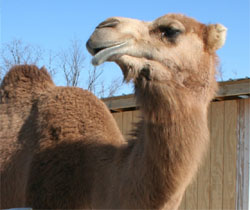At the Creation Museum’s petting zoo, you can meet an evergrowing collection of exotic animals while learning unforgettable facts about the handiwork of our amazing Creator. The long-term residents are still there—the popular hybrids Zoe the zorse (a zebra/horse mix), Cletus the zonkey (zebra/donkey mix), and Rico the huarizo (an alpaca/llama mix), who demonstrate the tremendous variety within God’s created kinds. But new attractions make the visit even more exciting and educational.
Coatis (Singular, Coati) Have Moved In

© Gabriela Insuratelu | Dreamstime.com
These animals’ endearing faces and child-like antics are fun to watch and are ready to steal your heart! Sometimes called coatimundis, coatis are members of the raccoon kind. Unlike modern raccoons, which love the night, coatis move about and forage during the day, especially mornings and evenings. They climb with ease. They can even climb down headfirst by turning their feet around 180 degrees—to find food on the ground as well as in the trees.
Gomer the Mild-Mannered Camel Now Gives Rides

He can carry a mound of kids weighing as much as 250 pounds (113 kg) on his powerful back. Riding Gomer isn’t like riding a horse, though. You’ll sit much higher and sway forward and backward gently as you imagine yourself traversing the wilderness in a caravan with Abraham or some other Hebrew wanderer—a ride you won’t soon forget! His specially designed hair insulates him from both heat and cold; in fact, during winter he often lies down in the snow.
Meet Tucker, the African Spurred Tortoise

© Marilyn Gould | Dreamstime.com
Tucker could easily outlive all his other zoo animal companions—and possibly even the human caretakers—since this amazing species can live longer than a century. This is the largest species of tortoise found on mainland Africa, with males growing to nearly 3 feet (1 m) long. Tortoises like Tucker are excellent diggers, creating sleeping burrows that can accommodate two or three tortoises. He can survive extended periods of drought by digging a burrow for himself.